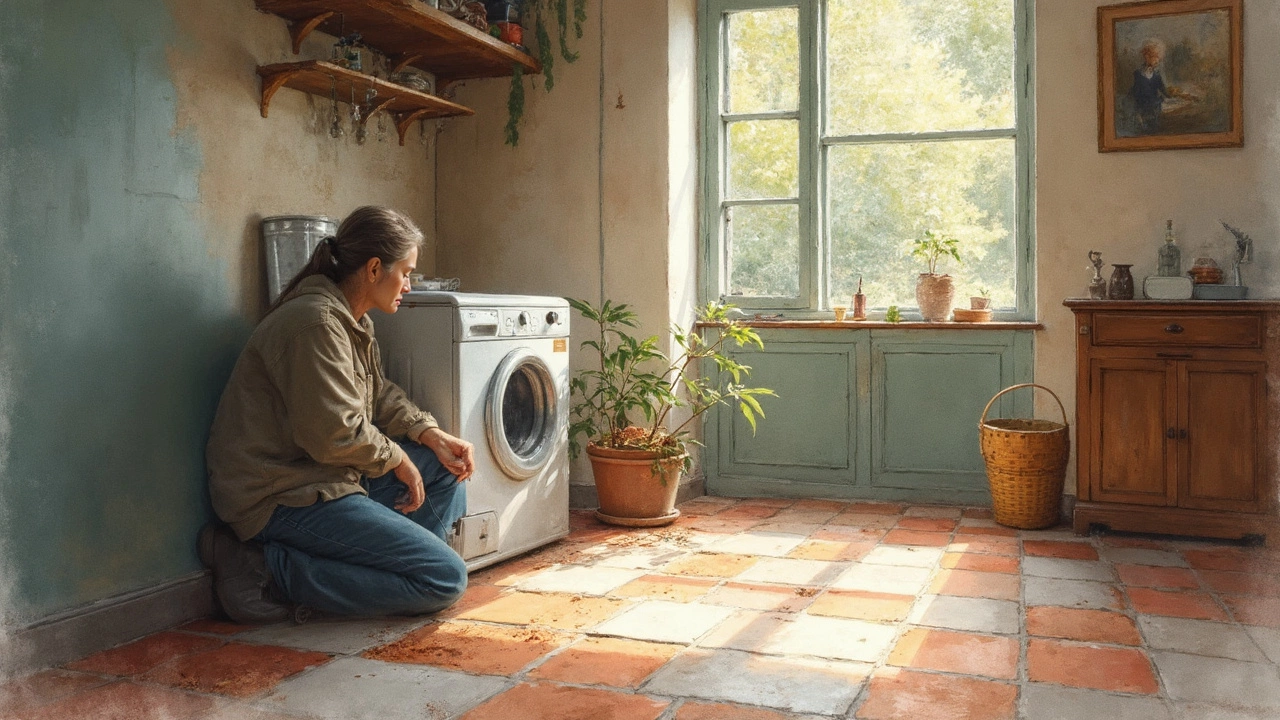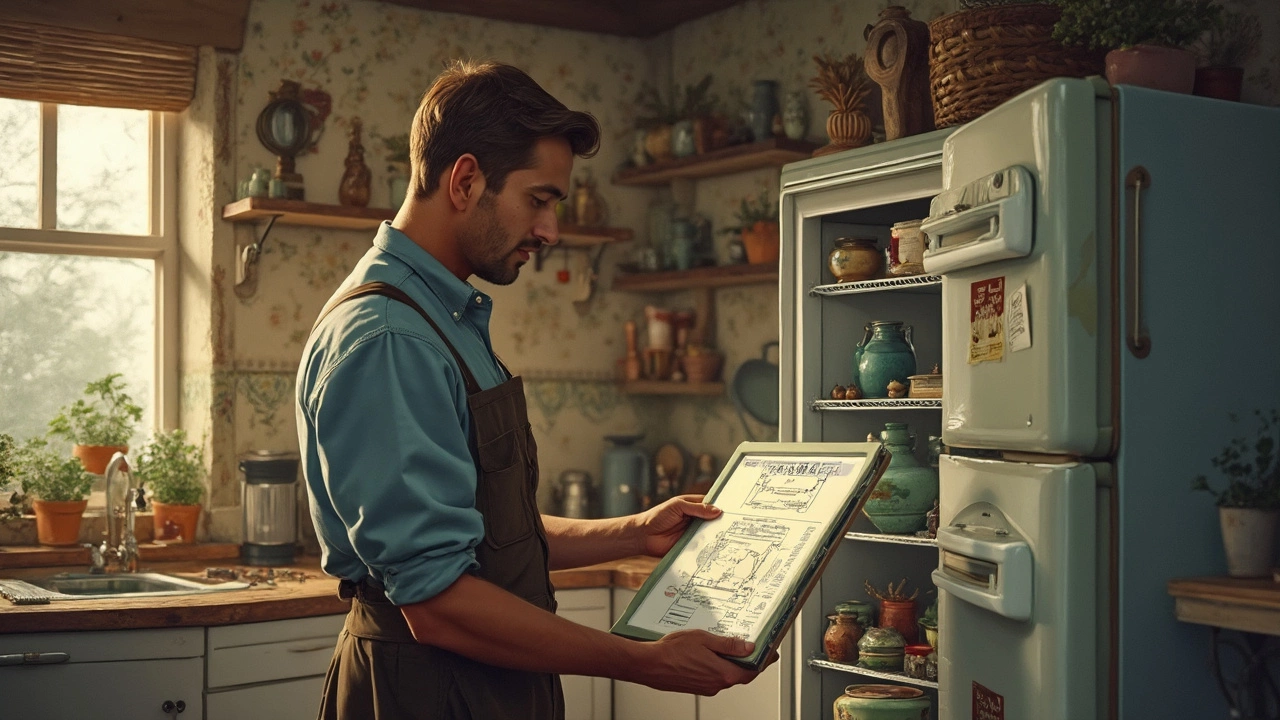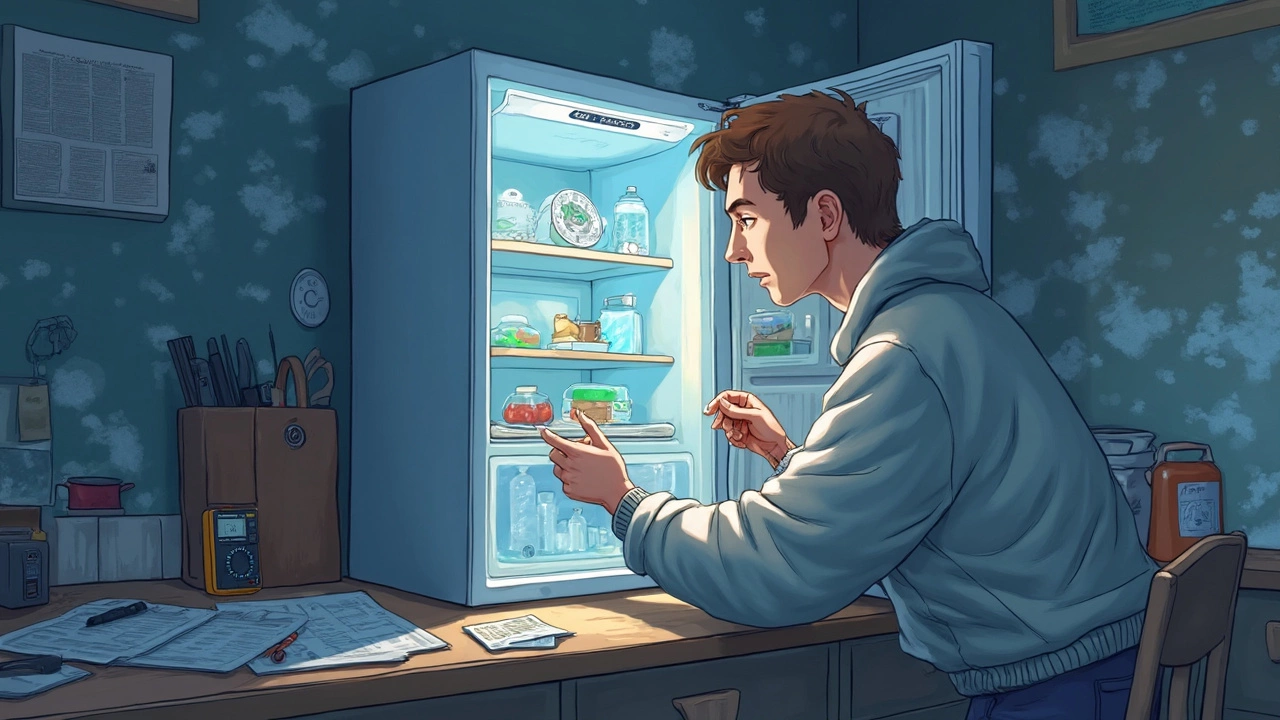So, your freezer's throwing a tantrum and not cooling? Annoying, right? But don't worry, it might not be a big deal to fix. Let's start with some basics: check if it's plugged in. It sounds silly, but power cords can sometimes get knocked out of place while cleaning or moving things around. No power, no cooling—simple as that.
Next up, you'll want to investigate the thermostat. Has it been turned down accidentally? Kids playing with the dial while searching for ice cream could accidentally adjust it. Make sure the temperature is set to the recommended freezing level, which is usually around 0°F (-18°C).
If that doesn't sort it, give the vents a once-over. These can get blocked with bags and boxes, making it hard for cool air to circulate. Peek inside the freezer and rearrange stuff if needed—it could be the easy fix you've missed.
- Understanding the Basics
- Checking Power Connections
- Looking at the Thermostat
- Inspecting the Vents and Coils
- Knowing When to Call a Pro
Understanding the Basics
Alright, so your freezer's not cooling, and it feels like a mini-disaster. But hang tight, because diving into the basics can solve a ton of issues. Start by ensuring the simplest thing: is it plugged in? Seriously, it's more common than you'd think for a cord to get nudged out of an outlet. Without power, that freezer won't stand a chance at keeping things cold.
Next, the thermostat is your best buddy. It's like your freezer's brain, dictating how chilly things get. Accidentally turning it too low (or too high) can cause chaos. Make sure it's set to the recommended 0°F (-18°C). If it's not, you're practically inviting warm air to hang out in there.
Now, let's talk about airflow. Blocked vents are the sneaky culprits behind many a cooling issue. If you've got bags of frozen nuggets or pizza plastered against the vent, cold air won't flow properly. Result? A freezer barely doing its job. Keep those vents clear for proper air circulation.
For some solid pedantic advice, if you're aiming for regular freezer repair maintenance, a monthly check on these aspects goes a long way. Trust me, a little routine goes a long way in keeping things functioning smoothly.
| Common Issues | Quick Check |
|---|---|
| Power Supply | Check plug and outlet |
| Thermostat Setting | Ensure 0°F (-18°C) |
| Airflow | Clear vents from obstructions |
Checking Power Connections
Alright, first things first—let’s ensure that your freezer actually has power. It's like trying to start a car with an empty tank—it just won’t happen. A freezer that isn't cooling could be a sign that something as simple as a power connection issue is to blame.
Start by diving behind your freezer. Make sure the plug is snugly connected to the outlet. If it’s just hanging there or barely touching, that might be your culprit. Try plugging in something else, like a lamp, into the same socket. If the light doesn't turn on, you might have a busted outlet.
If the outlet's fine and the freezer’s still not running, it’s time for a little extra detective work with the circuit breaker. Check your home’s breaker panel to see if a fuse is blown or a breaker is tripped. If you find a problem, reset it and see if this brings your freezer back to life.
Never underestimate the power of a good cord inspection, too. Look for signs of damage, wear and tear, or fraying on the power cord. If it looks suspect, that could be the reason your freezer isn’t chilling as it should. Better to replace a damaged cord than risk a bigger issue!
If these simple checks don’t solve the problem, it’s not looking like something you can DIY your way out of, and it might be time to call in the pros. Maybe you can borrow a neighbor's freezer while you figure this out!

Looking at the Thermostat
The thermostat is like the brain of your freezer, telling it how cold to get. If your freezer isn't doing its job, it’s time to see if the thermostat is the culprit. Start by locating it; usually, you'll find it inside the freezer, often on the back wall or near the front panel.
First things first, make sure the thermostat is set to the correct temperature. Ideally, your freezer should be at 0°F (-18°C). If you’ve got kids or overly curious guests who like fiddling with knobs, someone might have nudged it. Adjust it back and listen for a click—the sound of the freezer kicking back into action.
If it's already set correctly but still not cooling, try turning it off and on again. Just like restarting a computer, this can sometimes reset whatever's gone funky. No luck yet? It’s time to test it. Some thermostats are simple enough to test at home:
- Grab a multimeter—a handy tool you can find at hardware stores.
- Unplug the freezer to stay safe.
- Remove the thermostat and hook it to the multimeter.
- Check if there's continuity. If not, the thermostat's potentially busted.
If you suspect the thermostat needs replacing, don't fret; swapping it out is typically straightforward and relatively inexpensive compared to a full appliance repair. But remember, if you’re unsure, it might be time to consider professional help. A busted thermostat might just be the tip of the iceberg!
Inspecting the Vents and Coils
Your freezer's vents and coils are like its respiratory system. If they're blocked or clogged, your freezer can't do its job of keeping things icy. First things first, let's deal with the vents. These are usually located on the back wall or the floor of the freezer compartment. Blocked vents can restrict airflow, which might be why your freezer isn't cooling efficiently.
Start by moving any food items away from the vents to clear the way for proper air circulation. Stack those freezer goods with a little breathing room in mind.
Now, let's give those coils some attention. The condenser coils, typically located at the back or underneath the freezer, dissipate heat. Dust and debris can insulate these coils, causing them to overheat and fail at their cooling task.
Follow these steps to clean your condenser coils:
- Unplug the freezer for safety. You don't want any surprises while you're back there.
- Locate the coils. You might need to unscrew a panel to get to them.
- Using a vacuum cleaner or a coil cleaning brush, remove dust and debris. A clean set of coils means a more efficient freezer repair process.
- Plug it back in and give it a few hours to cool. Fingers crossed you'll notice a difference!
A fun fact—many people find that cleaning the coils saves energy. It's like giving your freezer a little tune-up, helping it run cooler and smoother without those annoying spikes in your electric bill.
If you've tried these steps and still find that your freezer is not cooling like it should, it might be time to consider other issues or even seek professional help. But often, a good ole cleanup of the vents and coils does wonders!

Knowing When to Call a Pro
Alright, let's get real—sometimes the freezer issues are above our DIY abilities, and it's time to bring in the experts. But when exactly do you throw in the towel and call a repair service for your freezer repair needs?
If you've tackled the basic stuff like power checks, thermostat adjustments, and ensuring vents are clear, yet your freezer is still misbehaving, it might be time. A big red flag is when you notice strange noises, like buzzing or clicking. These could signal deeper mechanical problems, like a faulty compressor or fan motor. Not cool, right?
The same goes for persistent ice build-up. Sure, a bit of frost is normal, but if you're chipping away at an iceberg every week, the defrost system might be on the fritz. According to Whitman Appliance Repair, "Over-loading your freezer can obstruct airflow, but significant frost issues often hint at malfunctioning components that require professional assessment."
"Sometimes what looks like a simple DIY fix can mask more complex issues underlying freezer malfunctions," says the National Association of Appliance Repair Technicians (NAART).
And let's not forget about leaks. A puddle under your freezer means there's a drainage problem, and trying to sort this by yourself might get messy. Save yourself a headache and call someone who knows their stuff.
Finally, consider how much your freezer repair will cost compared to just getting a new unit. If repairs are too frequent or costly, it might be a better deal to upgrade and enjoy the benefits of a brand-new, efficient model. If in doubt, a pro can give you an expert opinion that'll clear things up.

I am an expert in the services industry with a focus on appliance repair. My passion lies in understanding how things work and educating others in simple, engaging ways. This enthusiasm fuels my writing, where I delve into topics around appliance maintenance and troubleshooting. I aim to make these subjects clear and accessible to all readers.